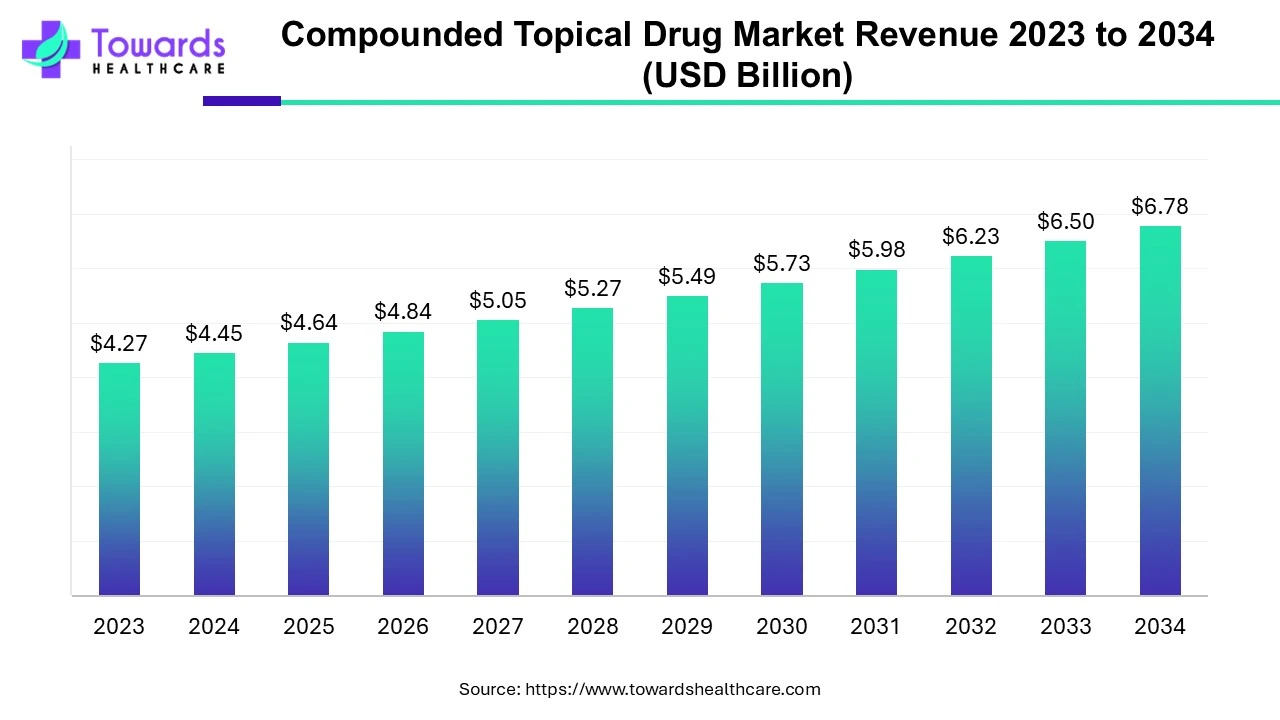April 2025

The compounded topical drug market was estimated at US$ 4.27 billion in 2023 and is projected to grow to US$ 6.78 billion by 2034, rising at a compound annual growth rate (CAGR) of 4.29% from 2024 to 2034. The demand for personalized medicines and the increasing incidence of skin disorders drive the market.

Compounded drugs are sterile or nonsterile drugs or nutrients formulated in a licensed pharmacy, outsourcing facility, or other healthcare-related facility. They are not FDA-approved for safety and effectiveness. Compounding involves combining, mixing, or altering ingredients tailored to the needs of the patients. According to the American Chronic Pain Association, the most common compounded medications are topical medications. Topical drugs are semisolid preparations or transdermal patches on the skin, mucous membranes, or cavities. Topical preparations treat pain for injured workers with a specific need. Topical agents are often prepared by mixing the powdered tablet in a petroleum base to form ointments.
The increasing incidences of skin disorders potentiate the demand for compounded topical drugs. According to the WHO, 1.8 billion people are estimated to be affected by skin conditions at any point in time. The demand for personalized medicines and the ease of preparation of topical drugs boost the market. If a person is allergic to any dye or ingredient, compounded preparations can be made without the dye or ingredient. The market is also driven by increasing drug shortages due to rising population and demand.
The latest technological advancements like artificial intelligence (AI) introduce automation in the compounding of products. These advancements lead to enhanced efficiency, improved accuracy, and increased safety. Conventional pharmacy compounding is a labor-intensive procedure involving careful human labor. Implementing AI in pharmacy compounding automates the entire process using state-of-the-art technology to streamline workflows and reduce the possibility of errors.
AI can incorporate precision and consistency by precisely measuring and dispensing drug components. It can also facilitate real-time monitoring, detecting, and correcting errors on a prior basis. Additionally, it unlocks valuable time for pharmacists to focus on delivering personalized patient care and medication counseling, ultimately leading to better health experiences for everyone. Hence, automation can significantly reduce the occurrence of human errors, leading to safer and more efficient compounding processes.
Since compounded topical drugs are not approved by regulatory agencies, they can cause severe side effects in patients. Unnecessary use of compounded drugs may expose patients to potentially serious health risks. Compounding too small quantity of medications provides lesser treatment efficacy, while more quantity of medications can lead to potential side effects.
North America held a dominant presence in the compounded topical drug market in 2023. The presence of key players, technological advancements, increasing demand for personalized medicines, and drug shortages drive the market. It is estimated that 1-3% of prescriptions in the US are for compounded medications. Compounding practices in the US are driven by the presence of key players like Apollo, Aurora, B Braun, Equashield, etc. These companies hold a major share of the US market. Companies like Equashield and Baxter use AI to incorporate automation in compounding drugs. The US Food and Drug Administration and Center for Drug Evaluation and Research do not regulate compounded drugs but release guidelines on safe and high-quality drug compounding.
Asia-Pacific is anticipated to grow fastest in the compounded topical drug market during the forecast period. The rising population, increasing incidences of skin conditions, diverse patient needs, and growing research and development drive the market. In India, registered medical practitioners can legally dispense medications for their patients and can get drugs compounded through pharmacies for their patients. The regulations for compounding drugs in India are mentioned in the Drugs and Cosmetics Act. In Japan, it is estimated that around 30% of the population suffers from atopic dermatitis due to rapid urbanization. The prevalence of psoriasis in China and Japan is about 0.56% and 0.34%, respectively. While the prevalence of psoriasis in India among adults varies from 0.44% to 2.8%.
By type, the cream segment held a significant share of the compounded topical drug market in 2023. Creams are the most common topical drug formulations used for diverse applications from pain management to eczema and psoriasis. The rising incidences of skin disorders and demand for personalized medicines drive the segment growth. Compounded topical creams frequently combine more than one API, and sometimes up to four to six APIs, depending on the patient's conditions.
The ointment segment is projected to expand rapidly in the market in the coming years. Ointments are widely used to soothe or heal wounds, burns, rashes, scrapes, or other skin problems. Ointments stay on the skin for longer periods, absorbing more medication and providing better treatment efficacy.
By application, the retail pharmacy segment is estimated to grow at a notable rate in the compounded topical drug market during the forecast period. Compounding is the most common application in retail pharmacies. Retail pharmacies have sufficient trained professionals to formulate compounded preparations. Patients can directly explain their conditions or difficulties in taking medications to the pharmacists present at retail stores, allowing them to prepare custom drugs.
By Type
By Application
By Region
April 2025
April 2025
April 2025
April 2025